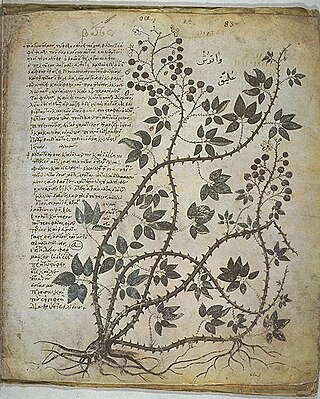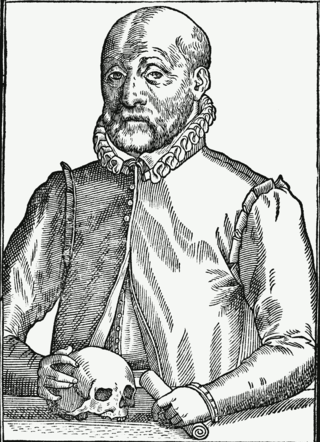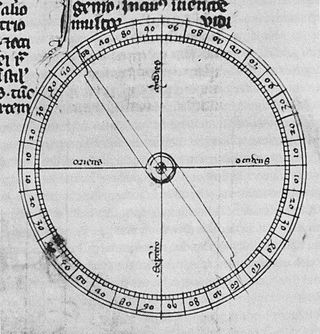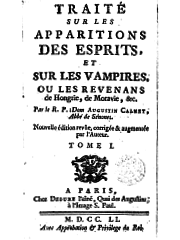Related Research Articles

Gerolamo Cardano was an Italian polymath whose interests and proficiencies ranged through those of mathematician, physician, biologist, physicist, chemist, astrologer, astronomer, philosopher, music theorist, writer, and gambler. He became one of the most influential mathematicians of the Renaissance and one of the key figures in the foundation of probability; he introduced the binomial coefficients and the binomial theorem in the Western world. He wrote more than 200 works on science.
Georg Joachim de Porris, also known as Rheticus, was a mathematician, astronomer, cartographer, navigational-instrument maker, medical practitioner, and teacher. He is perhaps best known for his trigonometric tables and as Nicolaus Copernicus's sole pupil. He facilitated the publication of his master's De revolutionibus orbium coelestium.

Claude Adrien Helvétius was a French philosopher, freemason and littérateur.

Materia medica is a Latin term from the history of pharmacy for the body of collected knowledge about the therapeutic properties of any substance used for healing. The term derives from the title of a work by the Ancient Greek physician Pedanius Dioscorides in the 1st century AD, De materia medica, 'On medical material'.

Johannes Wier was a Dutch physician who was among the first to publish a thorough treatise against the trials and persecution of people accused of witchcraft. His most influential work is De Praestigiis Daemonum et Incantationibus ac Venificiis.

Sebastiano Serlio was an Italian Mannerist architect, who was part of the Italian team building the Palace of Fontainebleau. Serlio helped canonize the classical orders of architecture in his influential treatise variously known as I sette libri dell'architettura or Tutte l'opere d'architettura et prospetiva.

Petrus Peregrinus de Maricourt (Latin), Pierre Pelerin de Maricourt (French), or Peter Peregrinus of Maricourt, was a French mathematician, physicist, and writer who conducted experiments on magnetism and wrote the first extant treatise describing the properties of magnets. His work is particularly noted for containing the earliest detailed discussion of freely pivoting compass needles, a fundamental component of the dry compass soon to appear in medieval navigation. He also wrote a treatise on the construction and use of a universal astrolabe.
Johannes Zacharias Actuarius, son of Zacharias, was a Byzantine physician in Constantinople. He is given the title of Actuarius, a dignity frequently conferred at that court upon physicians.
John Rutty (1697–1775) was a Dublin Quaker physician and naturalist born in Melksham, Wiltshire, England. He was the author of many texts including A methodical synopsis of the Mineral Waters of Ireland (1757) and An Essay towards the Natural History of the County of Dublin (1772). After his death his spiritual diary was published, and the botanist William Henry Harvey named the genus Acanthaceae Ruttya after him.

Emery Molyneux was an English Elizabethan maker of globes, mathematical instruments and ordnance. His terrestrial and celestial globes, first published in 1592, were the first to be made in England and the first to be made by an Englishman.

Edward Wright was an English mathematician and cartographer noted for his book Certaine Errors in Navigation, which for the first time explained the mathematical basis of the Mercator projection by building on the works of Pedro Nunes, and set out a reference table giving the linear scale multiplication factor as a function of latitude, calculated for each minute of arc up to a latitude of 75°. This was in fact a table of values of the integral of the secant function, and was the essential step needed to make practical both the making and the navigational use of Mercator charts.
The history of pathology can be traced to the earliest application of the scientific method to the field of medicine, a development which occurred in the Middle East during the Islamic Golden Age and in Western Europe during the Italian Renaissance.

Robert Hues was an English mathematician and geographer. He attended St. Mary Hall at Oxford, and graduated in 1578. Hues became interested in geography and mathematics, and studied navigation at a school set up by Walter Raleigh. During a trip to Newfoundland, he made observations which caused him to doubt the accepted published values for variations of the compass. Between 1586 and 1588, Hues travelled with Thomas Cavendish on a circumnavigation of the globe, performing astronomical observations and taking the latitudes of places they visited. Beginning in August 1591, Hues and Cavendish again set out on another circumnavigation of the globe. During the voyage, Hues made astronomical observations in the South Atlantic, and continued his observations of the variation of the compass at various latitudes and at the Equator. Cavendish died on the journey in 1592, and Hues returned to England the following year.

A Concise Treatise on the Art of Angling- Confirmed by Actual Experiences and Minute Observations to Which is Added the Compleat Fly-Fisher is a fly fishing book written by Thomas Best, first published in London in 1787.

Josefde Mendoza y Ríos (1761–1816) was a Spanish astronomer and mathematician of the 18th century, famous for his work on navigation. The first work of Mendoza y Ríos was published in 1787: his treatise about the science and technique of navigation in two tomes. He also published several tables for facilitating the calculations of nautical astronomy and useful in navigation to calculate the latitude of a ship at sea from two altitudes of the sun, and the longitude from the distances of the moon from a celestial body.
Baldo Angelo Abati was an Italian physician and naturalist. He lived in the second half of the sixteenth century.
Gerard Boate was a Dutch physician, known for his Natural History of Ireland.
The year 1570 in science and technology included a number of events, some of which are listed here.

Traité sur les apparitions des esprits et sur les vampires ou les revenans de Hongrie, de Moravie, &c. is one of the many works by an Abbot monk named Antoine Augustin Calmet, an exegete and an 18th-century Lorraine scholar of the Benedictine Order; also known as Dom Calmet. The work was published in 2 volumes that dealt with the extensive investigation into occult matters regarding the apparitions of angels, demons and other spirits.
Richard of Wendover was an English cleric and physician.
References
- ↑ Palmer, Alan; Palmer, Veronica (1992). The Chronology of British History. London: Century Ltd. pp. 163–165. ISBN 0-7126-5616-2.
- ↑ Opus discussarum concertationum praeclarum available at Gallica